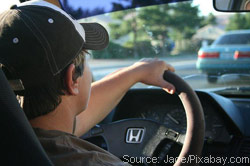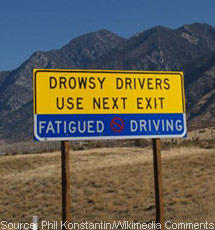 The thought of sharing the road with teen drivers gives some people anxiety. Others couldn't care less. But the fact still stands that motor vehicle crashes are the number one cause of death among teens in the United States. By utilizing a few tips for teen drivers, teens, parents and other drivers should feel a little safer on the roads.
The thought of sharing the road with teen drivers gives some people anxiety. Others couldn't care less. But the fact still stands that motor vehicle crashes are the number one cause of death among teens in the United States. By utilizing a few tips for teen drivers, teens, parents and other drivers should feel a little safer on the roads.
Gain experience
Practice does make perfect - well, at least almost perfect. Teen drivers (and new drivers) will likely make mistakes, but the best time to make them is when you're learning.
- Getting comfortable driving will prepare you for getting your license, and make you more confident when you're out there on your own without an instructor or parent.
- Get to know your car and how to do the basics - pumping gas, changing tires, jump-starting the car, adding windshield washer fluid, etc.
- Take short trips and gradually increase your distances to get more comfortable behind the wheel.
- Before driving at night, make sure you're fully comfortable driving during the day, and are familiar with your routes. You should also get your eyes checked to make sure your prescription is up to date.
Driving tips
- Obey speed limits - not only for the sake of avoiding tickets, but for safety's sake. Speeding shortens your reaction time which could mean the difference between stopping in time and hitting that expensive car in front of you.
- Buckle up. Seatbelts may be uncomfortable for some, but if you make the proper adjustments for your height, you won't even notice it's there, but you'll be glad it is when you need it.
- Make the adjustments you need to feel comfortable in your car. Adjust the head rest, the mirrors (the rear view and side view) and the air temperature - whatever you need. It's important that you get comfortable before you start driving so that you're not trying to make adjustments while you're driving.
- Keep two hands on the wheel when you're driving. Experts recommend keeping them at 3 and 9 o'clock or at 4 and 8 o'clock. In the event of an accident, your hands will stay out of the airbag's way when it deploys.
Bad weather tips
Rain, snow, sleet and even wind make driving more dangerous.
- Rain
- If your windshield wipers are on then your lights need to be on. You'll avoid a ticket and you'll be able to see.
- Allow for more stopping space when you brake. Your car is likely to slip and hydroplane on a slick surface and into another car or object if you don't stop in time.
FYI: The most dangerous time to be on the road is when it starts raining - oils on the road and the rain water begin to mix and create an even slicker road condition.
- Snow
- Brake gently when driving on a slippery surface like ice or snow and use gentle pressure when accelerating. If your tires begin spinning, let up on the accelerator until you regain traction.
- Keep your tailpipe clear if you get stuck and have to dig out your car. Blocking the tailpipe will cause poisonous carbon monoxide to circulate into your car and you'll end up breathing it in.
TIP: Keep kitty litter, sand or another grainy material in your trunk in case you get stuck somewhere. The added traction will allow you to drive out of the spot.
- Ice and sleet
- Keep an ice scraper and brush in your car to clear off your car during the winter. Be sure to clear off the entire car before driving including your roof, trunk and hood.
- Bridges and overpasses usually freeze over faster than roads.
- Test your brakes to see how much space you'll need to stop when the weather is bad.
Avoiding accidents
Distracted driving is one of the many reasons for accidents and not just among teens.
- DO NOT text while driving
- DO NOT take calls while driving - not even on speaker phone.
- DO NOT change the radio station, scroll through your MP3 player, change your GPS or any other electronic device while in motion.
- Pull over if you need to take a call, adjust your GPS device or anything else that will take your eyes off the road.
Driving under the influence
Driving while drunk, buzzed, tipsy or even after just one drink is not worth it. The same goes for driving under the influence of drugs -just don't do it.
Fatigue
 Drowsiness can sneak up on anyone when you're driving. Many states have imposed driving curfews for teens for that reason. Look out for these signs when you're driving:
Drowsiness can sneak up on anyone when you're driving. Many states have imposed driving curfews for teens for that reason. Look out for these signs when you're driving:
- Excessive yawning.
- Trouble keeping your eyes open.
- Driving over the rumble strips more than once.
- Inability to remember the last few minutes or seconds.
What should you do?
- Slow down and pull over into a safe area, lock your doors and take a nap.
- Make a pit stop. Use the bathroom; get a soda, coffee or something to drink.
- Open your windows or blast cold air in your face.
- Play your music loudly and try to sing along.
- If you have a passenger, talk to them or switch with them.
If you've been in an accident
- Call 9-1-1 immediately if someone is injured. If everyone is OK, then assess the scene.
- If possible don't move the cars until photos have been taken.
- Call the police to report the accident before calling anyone else. Other drivers may try to stop you from reporting the accident, but many states require that you notify the police.
- Exchange information with the other driver(s) involved. Get their name, license plate, phone number, address, and insurance information.
- Take photos. Get the position of the cars, the damage and anything else that may be relevant. Keep a disposable camera in your car if you don't have a camera phone.
- Get names and numbers of any witnesses to the accident.
- Take notes of the accident while they're still fresh in your mind.
- Call your insurance and begin the claims process.